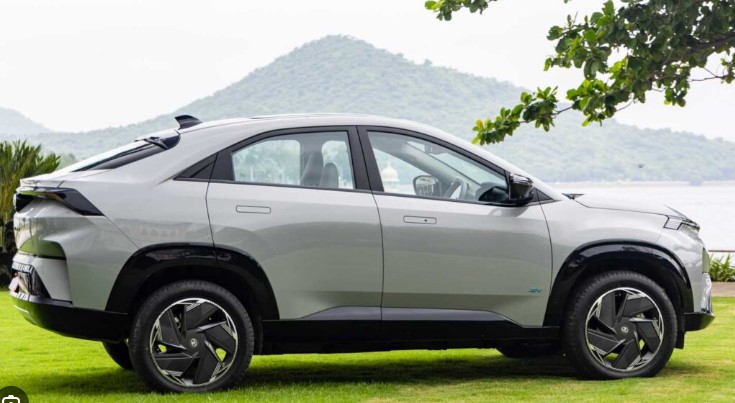
Tata Harrier EV Range Test & Review
Tata Harrier EV range test results are finally out, and the numbers are promising. Tata Motors recently launched the highly anticipated Harrier EV with prices starting at ₹21.49 lakh (ex-showroom) for the base variant, while the top-end Stealth Edition is priced at ₹30.23 lakh. Within 24 hours of opening bookings on July 2, the electric SUV surpassed 10,000 reservations—proving its popularity among Indian EV buyers.
The first dispatches have already reached dealerships across India, and we got exclusive access to drive the Harrier EV, perform a detailed 100 to 0 percent range test, and assess its real-world capabilities. Tata is also offering a ₹1 lakh loyalty bonus for existing Tata EV customers—making it an appealing upgrade for Nexon EV users.

Battery, Range, and Charging
The Tata Harrier EV is built on the Acti.ev+ platform and is available with two battery options: 65 kWh battery (available in Adventure, Adventure S, and Fearless+ trims) 75 kWh battery (available in Fearless+, Empowered RWD, and Empowered AWD trims)
Tata claims a real-world range of up to 505 km on a single charge for the 75 kWh variant. In our controlled 100-0% range test, the Harrier EV covered approximately 492 km under mixed driving conditions—city traffic, highway cruising, and short off-road stretches. This puts the Harrier EV among the most efficient long-range electric SUVs currently available in India.
Table of Contents
ToggleCharging compatibility includes fast AC charging (up to 11 kW) and support for DC fast chargers, enabling a 10–80% top-up in under 60 minutes for the 75 kWh battery.

Powertrain and Performance
Powering the Harrier EV is a Permanent Magnet Synchronous Motor in the RWD variants delivering 238 PS and 315 Nm of torque. AWD variants feature a dual-motor setup (front induction + rear PMSM) generating a combined 504 Nm, offering superior grip and performance on challenging terrain.
Tata provides multiple driving modes—Eco, City, Sport (for RWD), and an exclusive Boost mode for AWD variants. During our test drive, Boost mode added a noticeable punch on open stretches and steep inclines, making it one of the most fun-to-drive electric SUVs in its segment.

Key Features and Interior Experience
One of the standout features of the Harrier EV is the new Samsung-sourced QLED touchscreen infotainment system, which offers sharp graphics and fast touch response. Standard safety across variants includes:
6 airbags
All-wheel disc brakes
Tyre Pressure Monitoring System (TPMS)
ESC and hill hold assist
Interior quality is premium, with vegan leather upholstery, a panoramic sunroof, wireless charging, ventilated front seats, and connected car tech. With a water wading depth of 600 mm and 47% gradeability, the Harrier EV is ready for mild off-roading as well.

Tata Harrier EV vs Kia Carens Clavis EV
Kia has entered the EV race with the launch of the Carens Clavis EV, its first India-made electric vehicle. Priced from ₹17.99 lakh (ex-showroom) for the HTK+ variant, it directly competes with the lower trims of the Harrier EV. The Clavis EV offers two battery options:
42 kWh (range: 404 km IDC)
51.4 kWh (range: up to 490 km IDC)
Unlike the Harrier EV’s off-road focus and larger battery packs, the Carens Clavis is better suited for urban commuting. It comes in six colors and four variants—HTK+, HTX, HTX ER, and HTX+ ER—with prices going up to ₹24.49 lakh (ex-showroom). Key features include:
Twin-screen dashboard setup
Full-length LED light bar
Overhead rear AC vents
Wireless charging
ADAS with 6 airbags
However, real-world range figures are yet to be independently tested for the Clavis EV. The Harrier EV, with its AWD option, greater torque output, and longer tested range, clearly positions itself as a more robust offering for performance enthusiasts and long-distance EV drivers.
Market Outlook & Final Thoughts
The electric SUV space in India is heating up rapidly, and both Tata and Kia are making bold moves. The Tata Harrier EV stands out with its rugged looks, real-world range of nearly 500 km, AWD capabilities, and feature-rich cabin. For buyers looking for a premium, long-range EV with excellent road presence and proven performance, it delivers compelling value.
The Kia Carens Clavis EV is a practical, city-focused electric family car with strong design elements and efficient battery options—but may fall short for those seeking adventure-ready electric mobility.
With the government promoting EV adoption and charging infrastructure steadily improving, both vehicles are well-timed entries. However, the Harrier EV’s range test results, design, and drivetrain versatility give it a competitive edge in the growing Indian EV SUV segment.
Centre’s Approval of New Chip Plant in Andhra Sparks Telangana’s Anger Over Alleged Bias
Centre’s Approval of New Chip Plant in Andhra Sparks Telangana’s Anger Over Alleged Bias The Chip plant approval in Andhra Pradesh […]
Elon Musk Warns Satya Nadella About OpenAI After GPT-5 Launch: Microsoft CEO Responds
Elon Musk Warns Satya Nadella About OpenAI After GPT-5 Launch: Microsoft CEO Responds Elon Musk warns Satya Nadella about OpenAI […]
Who Is Shyam Sankar? The Billionaire Technologist Powering Palantir’s AI Boom Shyam Sankar, Palantir Technologies’ Chief Technology Officer, is emerging […]
Rupee at Risk of Lifetime Low as Trump Threatens Tariffs on Indian Goods The rupee at risk of lifetime low […]
China Electronics Investment Tied to Tech Transfer in India
China Electronics Investment Tied to Tech Transfer in India The future of China electronics investment in India may rest on […]
HDFC AMC Q1 Results: Net Profit Jumps 24% to ₹748 Crore, Income Rises 26.5% HDFC AMC Q1 results for the […]








